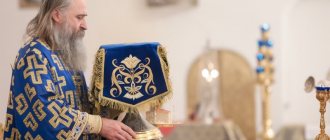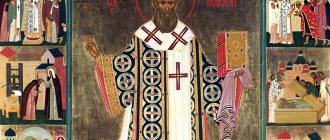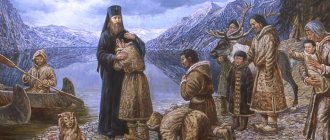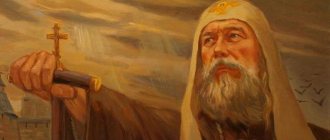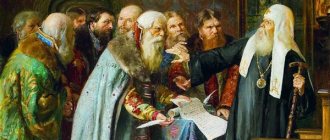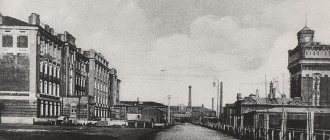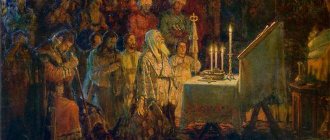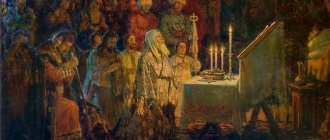On the way to asceticism
Saint Peter of Moscow was born into a pious family on the Volyn land. His father's name was Theodore, and his mother's name (according to some sources) was Eupraxia.
The parents learned from Revelation that the son would be chosen by the Omniscient God for a special service, that he would glorify Him and that he himself would be glorified even before his birth.
One day at dawn, the mother saw an extraordinary lamb in a dream (according to the plot of the vision, she carefully held it in her arms). Between the horns of the lamb grew a wonderful tree, replete with many fruits and flowers. Candles burned among the lush foliage. With all this, the tree exuded an indescribable fragrance. Waking up, Eupraxia could not explain to herself what this vision meant. And only later it became clear that the content of the dream pointed to the spiritual gifts of her son (who was then in his mother’s womb).
Until the age of seven, Peter was trained and raised in his parents' home. And then he was sent to study literacy and book sciences. He studied with diligence, but the teaching did not yield to him. This saddened the boy and upset his parents. But then, one day, a certain man in holy vestments appeared to him in a dream. A radiance poured out from him. At the word of the one who appeared, Peter opened his lips and he, blessing, poured sweetness into them. After this incident, Peter began to study more successfully and over time surpassed his peers.
Even in his youth, he preferred the difficult but faithful one - monasticism - to all possible paths of his life, and entered a monastery.
Monastic path
While asceticizing in the monastery, he humbly and zealously fulfilled the obediences assigned to him, spent a lot of time praying and reading the Word of God, and studied icon painting. Subsequently, he mastered this Christian art and became a true master. The images created by his work were distributed among the monastery brethren and pilgrim visitors.
Step by step Peter grew in spiritual age. Seeing in the monk a model of morality, purity and ability for pastoral work, the abbot of the monastery ordained him as a hierodeacon, and then as a hieromonk.
Carrying out this responsible service, Father Peter, with his characteristic sincerity, sought to bring more benefit to the brethren entrusted to his care, but over time, following the example of many great ascetics, he began to seek solitude in order to completely devote himself to deep Christian prayer and contemplation.
Having received a blessing in this regard from the abbot, Father Peter, leaving the monastery, went in search of a suitable deserted place. Having found it with the help of God near the Rata River, he mortgaged and built himself a modest, small cell. Here he spent many days and nights in communication with God.
Temple in honor of the saint
Among the most famous buildings of this saint is the Church of Peter the Metropolitan of Moscow in St. Petersburg. It’s not difficult to find it at the intersection of Romenskaya and Dnepropetrovskaya streets. It belongs to the St. Petersburg Diocese of the Russian Orthodox Church. It was built in 1911-1912 on the territory of the Holy Trinity Tvorozhkovsky Convent.
For a long time after the revolutions, the monastery was buried, and all valuables were removed from it. Then the buildings were transferred to the plant, and the structures were dismantled, the buildings were rebuilt, and the interior was destroyed. And only in 1994 it was returned to the complex of the diocese's courtyard. Since then, reconstruction work has been underway there to return it to its previous condition. Thanks to the donations of caring people and parishioners, the goal is gradually being achieved. You can find more information about it online on the parish website.
Education of the monastery
When rumors about the exploits of the holy hermit spread throughout the surrounding area, believers began to flock to him, seeking spiritual nourishment. Over time, a monastery was formed on that very spot.
The brethren elected Father Peter as abbot of the monastery. It is known that in this responsible position he showed himself not only as a loving shepherd, instructing by word and personal example, but also as an excellent organizer.
The glory of the new monastery grew day by day. Many people, even eminent ones, even Prince Galitsky Yuri Lvovich, came there, wanting to listen to the abbot’s instructions and ask for his pastoral blessing and heartfelt prayers.
Once, the monastery was visited by Metropolitan Maxim of Vladimir, who was making a tour of Russian lands. Father Peter, having received the saint's blessing, humbly presented him with a gift of the icon of the Dormition of the Blessed Virgin Mary, made with his own hand. According to legend, Vladyka Maxim prayed in front of this image until the end of his earthly life.
The tomb of St. Peter in the Assumption Cathedral and the canonization of the metropolitan
The consecration of the Assumption Cathedral took place in August 1327 after the death of Peter, who left this world eight months earlier. A stone coffin was built for him in the church, made at the request of the Metropolitan during the life of the saint.
The Russian people deeply revered Peter, under whom the Moscow principality rose to prominence. In 1339, Saint Theognostus canonized his predecessor. Russian princes came to the saint’s tomb to kiss the cross and swear allegiance to the Moscow princes. State treaties were approved in Peter's name. At that time, Novgorodians had the right to elect their ruler. When Novgorod joined the Principality of Moscow, its archbishops were appointed to serve near the tomb of St. Peter. The election of Moscow high priests also took place here.
Activities of Saint Peter as Metropolitan
By the end of the thirteenth century, the robbery and violence committed by the Tatar conquerors reached such a scale that people began to flee Kyiv en masse. In 1299, Metropolitan Maxim, guided by considerations of church economy, moved from Kyiv to Vladimir.
Prince Galitsky did not approve of this step. He wanted the Metropolitan to be closer to him. For this purpose, he decided to appoint Abbot Peter to the metropolitan see, and sent him to Constantinople. At this time, Metropolitan Maxim reposed.
Mikhail Tverskoy, who then occupied the grand-ducal throne, guided by his own interests, tried to appoint Abbot Gerontius to the metropolitan see, for which he also sent him to the Patriarch of Constantinople. At the same time, Gerontius did not fail to take with him the holy staff, utensils, and even an icon painted and presented to the Metropolitan by Peter.
Of the two candidates, God Himself chose the worthy one. When Gerontius was sailing on a ship along the Black Sea, at night, during a storm, the Heavenly Queen appeared to him and unambiguously announced that the metropolitan throne would go to the Ratsky abbot. And so it happened: Patriarch Athanasius of Constantinople installed Peter as Metropolitan, and elevated him to the dignity of Metropolitan of All Rus'.
Returning to his homeland in 1308, the saint lived in Kyiv for about a year, after which he moved to Vladimir: where his predecessor established the department of Metropolitan of All Rus'.
Times were difficult. On the one hand, there are disagreements and discord between the princes. On the other hand - the Tatar yoke. Some northern rulers expressed extreme dissatisfaction with the installation of Peter on the see, disturbing and outraged the people.
Saint Peter often changed places of residence. People needed consolation, encouragement, and pacification, but most of all they had to take care of preserving, spreading and strengthening the true faith.
At some point, a confrontation arose between Yuri of Moscow and Mikhail Tverskoy: both wanted to see themselves on the grand-ducal throne. It was hardly possible for Metropolitan Peter to completely distance himself from this struggle, because it concerned not only the two arguing princely persons, but also their subjects, Orthodox people.
The saint considered it right to take Yuri’s side, which, of course, caused the discontent of Mikhail Tverskoy and his entourage. In response to the choice of Metropolitan Peter, they drew up an accusation against him and brought it to the ears of the Patriarch. He was in no hurry to trust the accusations and decided to thoroughly investigate the case. Convened on this occasion in 1311, the Council in Pereyaslavl acquitted the Russian saint.
In 1312 or 1313, Metropolitan Peter, out of church and state necessity, made a trip to the Horde, where he met with Khan Uzbek, received from him a letter confirming previous benefits for the clergy and giving the metropolitan the right to judge church people.
After the death of princes Mikhail and Yuri, the khan's label for the great reign was given to Mikhail's son, Alexander Tverskoy, who, taking advantage of the situation, entered into a struggle for power and influence with Ivan Kalita (Moscow). This time, Metropolitan Peter again inclined his favor to the side of Moscow.
| ◦◦◦◦◦◦◦◦◦◦◦◦◦◦◦◦◦ ◦◦◦21◦◦◦◦◦◦◦◦◦◦ Back December 21/January 3 Next ◦◦III◦◦◦◦VII◦VIII◦◦◦◦XII | Lives of the Saints | ◦ Search ◦ |
According to St. Dimitry Rostovsky:
Mts. Juliana and with her 500 husbands and 130 wives, suffered in Nicomedia;
St. Moscow Peter, wonderworker of all Russia;
Mch. Themistocleia.
According to St. Theodosius of Chernigov:
Blgv. book Juliania Vyazemskaya;
Blzh. Procopius, Christ for the Fool's Sake, Vyatka.
Life of Saint Peter, Metropolitan of Kyiv and All Russia
WITH
Saint Peter, Metropolitan of Kiev and All Russia, was born in the land of Volyn, from pious Christian parents. When he was still in his mother's womb, at dawn of one Sunday, his mother saw the following vision: she imagined that she was holding a lamb in her arms, in the middle of whose horns a densely leafed tree had grown, with many fruits and flowers, among its branches there were many candles - shining and giving off fragrance.
Waking up, the mother was perplexed about the wonderful vision, but subsequently the Lord justified the vision, enriching her son with His gifts.
At the age of seven, Saint Peter was sent to study the Divine Scripture, but at first he studied poorly, about which his parents were much saddened. This was so that he would receive book wisdom more from God than from people. And indeed, Saint Peter received it in this way.
One day he saw in a dream that a certain man in holy robes came to him and said to him:
- Child, open your mouth!
When Peter had done this, the one who appeared touched his tongue with his right hand and, blessing him, filled his throat with sweetness.
Waking up, the boy did not see anyone, but only felt in his heart a kind of sweetness and joy.
From that time on, Saint Peter began to quickly understand what his mentor taught; he soon studied all the Holy Scriptures and surpassed all his peers in teaching.
When Peter was twelve years old, he went to a monastery close to his birthplace and was accepted into the ranks of the brethren; there he carried out monastic obediences, carried water and firewood to the kitchen, washed the brethren's hair shirts, and neither in winter nor in summer did he abandon his rule. He came first to church services and was the last to leave; he stood in church with reverence, diligently listening to the Divine Scripture, never leaning against the wall; he always showed obedience to his mentor and readily served the brethren in humility and silence. By the will of the abbot, he was promoted to deacon, and then to presbyter. He also learned to paint holy icons and, when he painted, with all his mind and thought he moved away from earthly things and, filled with thoughts of God, zealously strived for a virtuous life.
After a rather long stay in that monastery, with the blessing of the abbot, Saint Peter retired to a deserted place and built himself a monastery near the Rata River. Here he built a church in the name of our Savior Jesus Christ, and in a short time many brethren gathered here to join him.
The saint was kind and gentle and considered himself the lowest of all; He taught everyone with meekness, diligently gave alms, never letting a beggar and a stranger go without help, so that rumors of his virtuous life reached the prince. Therefore, he was revered by everyone, and everyone accepted his word of instruction.
At that time, Metropolitan Maxim arrived in Rus' from Constantinople, teaching the people the God-devoted teaching. Appearing to him with his brethren to receive a blessing, Saint Peter presented him with an icon of our Most Holy Lady Theotokos, which he himself painted. The saint of God blessed him and the brethren and, having received the holy icon, kept it with him in great honor.
A little time later - when Saint Maximus reposed - a certain Gerontius dared to seize the priesthood, take the hierarchal robe, the sacristy and the pastoral staff, as well as the icon that Peter painted and presented to Saint Maximus, and went to Constantinople, wanting to become a Russian metropolitan.
Then the prince of the Volyn country began to invite blessed Peter, either by asking himself or by persuading him through the boyars, to go to Constantinople for consecration to the throne of the Kiev Metropolis, for no one sympathized with Gerontius for his audacity, with which he hastened to seize the priesthood without advice or election: “ I didn’t enter through the door, but climbed over
"(John 10:1).
Blessed Peter did not want to and refused for a long time, but finally, having been begged by the prince, the boyars and the council of saints, he went, and the prince sent a message about him to the most holy patriarch and to his entire council, expressing his desire to see Peter on the holy throne.
When Gerontius set off by sea to Constantinople, the voyage turned out to be unfavorable for him: a strong storm arose, contrary winds and waves, so that he slowed down a lot of time on the way. For blessed Peter, there was a calm and fair wind on the same sea, and he, as if in a dream, swam across the sea.
At the same time, the above-mentioned icon of the Most Holy Lady appeared to Gerontius in a vision, and said to him:
“You are working in vain, elder, for you will not get the holy rank that you are looking for.” But the one who wrote me - the Ratskiy abbot Peter - the servant of My Son and God and Mine, will be elevated to the throne of the saint and will rightly shepherd His people, for whom My Son - Christ the Lord - shed His blood, received from Me, and lived pleasingly to God, in his good old age he will joyfully go to the Lord of all.
Gerontius woke up in fear and told everyone about the vision.
Finally, Saint Peter reached Constantinople, the Patriarch of Constantinople was then Athanasius - a wondrous man who adorned the ecumenical throne with his virtues. When Peter came to the patriarch, the temple was filled with a fragrance; the patriarch, enlightened from above, realized that such a fragrance was for the sake of the coming of Peter, and joyfully blessed him. Then, having learned about the reason for his arrival, the patriarch convened a council of saints and they carried out the usual consideration of the case. Peter was recognized as worthy of the priesthood, having been predestined for this before his birth.
So the patriarch, during the performance of the divine service, dedicated this wondrous Peter to the holy service, and the face of the saint of God, during the dedication, shone so much that everyone marveled and said:
“Truly this man came to us at the command of God,” and everyone was filled with spiritual joy.
A few days later, Gerontius arrived in Constantinople and (albeit against his will) told about everything that had happened to him. The Patriarch, having taken from him the holy robes, the honorable icon, the pastoral staff and church utensils, gave everything into the hands of the true shepherd - Peter.
Then the Most Holy Patriarch, having sufficiently instructed Saint and Blessed Peter for many days and blessed him, released him with honor from Constantinople.
Saint Peter, having arrived in his metropolis, gave peace and blessing to everyone and diligently taught the flock entrusted to him by God, moving from one place to another.
But the crafty enemy could not bear this and devised intrigues against Saint Peter, inspiring some not to recognize him as a saint. However, many of these later repented, accepted the saint and, submitting to him, received forgiveness from him.
After some time, the crafty enemy aroused envy of Saint Peter in Andrei, Bishop of Tver, who, without curbing his tongue, began to spread false reports about the righteous man and, having written many false and blasphemous words, sent them to His Holiness Patriarch Athanasius. The patriarch was surprised and considered it incredible, but he sent one of the church clerics to the Russian land, and then a council was convened in the city of Pereyaslavl. Present at that council were Bishop Simeon of Rostov, Reverend Prokhor, abbot of Pechersk, princes, boyars, priests, monks and a great many others. When Bishop Andrei of Tver was called to the council, they began to investigate the matter, and when false witnesses came forward against Peter, great confusion occurred. The culprit of the evil did not hide, but was revealed to everyone. Andrei's malice and slander were exposed, and the lying slanderer was put to shame and humiliated before everyone. Saint Peter did not do him any harm, but forgave him and, having taught everyone enough, sent the council away in peace. He himself put in the work, multiplying the talent given to him by a hundred and being a father to orphans.
At that time, a certain heretic Seit appeared, who preached a teaching contrary to the Church of Christ and the Orthodox faith; the saint of God excommunicated him, and the evil heretic soon died an evil death.
After this, the saint of God Peter arrived in the glorious city of Moscow, which at that time was in the possession of the blessed Grand Duke John Daniilovich, adorned with all sorts of virtues, merciful to the poor and the clergy, who loved churches and was devoted to sacred books. The saint fell in love with him very much and began to live in that city more than in other places. He advised the noble prince to build a stone church in Moscow in the name of the Dormition of our Most Holy Lady Theotokos and Ever-Virgin Mary, thus convincing him:
“If you listen to me, my son, and create a temple to the Most Holy Theotokos, then you yourself will become glorified more than other princes and your city will be glorified: the saints will live in it and raise their hands against his enemies and God will be glorified in it, and my bones are laid here.” there will be.
Having listened to the advice of the saint, the prince began to take care of building the church. When the church was founded, work on its construction took place every day, and the saint himself watched to see that the work was constantly moving forward.
Shortly before the blessed death of Saint Peter, Prince John Daniilovich had the following dream. He imagined a high mountain, the top of which was covered with snow, and then suddenly the snow melted and disappeared. When the prince recounted to the saint the dream that had struck him, the saint said:
“The high mountain is you, the prince, and the snow is me, the humble one, who must soon depart from this life into eternal life.”
Having foreseen, according to Divine revelation, his imminent death, the saint of God himself, with his own hands, built himself a tomb near the altar in the newly built church of the Most Holy. Mother of God. And when the tomb was ready, he again received a revelation from God about his death. Filled with joy, the saint went to church and performed a divine service, praying for all the Orthodox kings and princes, for his spiritual son - the pious Prince John - and for all the pious Christians of the Russian land; then he commemorated the deceased and took communion of the Holy Mysteries. Returning from church, he called all the clergy and, having given instructions according to custom, dismissed them. At that time, he distributed a lot of alms to the poor and needy, churches, monasteries and clergy. Meanwhile, his body was rapidly weakening. When the day of his death came, the saint called to him the thousand-year-old Velyaminov, who then ruled the city (since the prince himself was not in the city at that time), and said to him:
“Here, child, I am leaving this life, but to my beloved son, Prince John and his descendants, I leave mercy and peace and the blessing of God forever.”
Then, having made other orders, St. Peter handed him a bag of money in order to complete the construction of the church. Having taught peace to everyone, he began to sing Vespers, and when the prayer was still on his lips and he himself raised his hands to God, his soul departed to the Lord.
The prince, having heard about the repose of the saint, hurried in sadness with all the boyars to the city, all the people cried and grieved over his repose. Having laid his honest body on the bed, they carried it to the church according to custom.
At that time, a certain person, possessed by unbelief, approached the body of the saint among the Orthodox people and in his thoughts began to reproach him, thinking:
- Who is this dead man, whom the prince himself and so many people are seeing off, and why is such honor given to him?
When he thought this, he immediately saw the saint sitting on his bed and blessing the people on both sides the entire time until he was brought to the tomb. Then the man believed in the holiness of the saint of God and told the people about what he had seen. Having brought the holy relics of Peter to the temple, they placed them in a stone tomb prepared by him himself, where they rest to this day, exuding various miracles with faith flowing to them. A certain young man from birth had weakened and completely motionless hands, so that he could not bring them to his lips. He came to the tomb of this saint, praying with tears, and immediately his hands strengthened and became healthy. The saint also healed one crumpled man and gave hearing to a deaf man. And one, who had been blind for many years, when he came and prayed, his eyes were suddenly opened. Many other blessings are still miraculously flowing with faith to those who come to the honest shrine of St. Peter - in honor and glory in the Trinity, glorified to God forever. Amen.
Troparion, tone 4:
The formerly barren earth, now rejoice: behold, Christ is a lamp in you, shining clearly in the world, and healing our ailments and illnesses. For his sake, rejoice and rejoice with boldness: for the saint is the work of this Most High.
Another troparion, tone 8:
Rejoice, the most blessed city of Moscow, having within you Bishop Peter like the dawn of the sun, illuminating all Russia with miracles: for he heals that infirmity, and drives away ailments like darkness from those who cry out to him: Rejoice, hierarch of the Most High God, who through you has done good for your flock.
Kontakion, tone 8:
To the chosen and wondrous wonderworker of our land, today we flow to you with love, weaving a god-bearing song: for having boldness in the Lord, deliver us from manifold circumstances, so that we call to you: Rejoice in the establishment of our city.
________________________________________________________________________
Volyn is the southwestern part of Russia.
Parents of St. Peter there were people of sufficient wealth and belonged to the boyar or merchant class, why St. Peter subsequently had the opportunity to build a monastery at his own expense.
According to the testimony of ancient life, St. Peter learned the art of icon painting to such an extent that he became a “wonderful icon painter.” The monuments of this to this day are two icons of the Mother of God located in the Moscow Great Assumption Cathedral, painted by him: the Dormition of the Mother of God and the other, after his name, deliberately known as Petrovskaya.
This place was located north of the capital of the Galich-Volyn principality - Lvov; The Rata River flows in what is now Austrian eastern Galicia and flows from the left into the upper western Bug. - Monastery of St. Peter, built in the name of the Savior (Preobrazhensky), does not currently exist; in its place there is now a village, with a parish church also in the name of the Savior.
St. Maxim, Greek by birth, ruled the Russian Church from 1283 to 1304.
One of the abbots of Vladimir.
Here, of course, the Galician-Volyn prince Yuri Lvovich, who was indignant at the self-will of Gerontius, especially since in Volyn those dissatisfied with the removal of the see from Kyiv to distant Vladimir wanted to see the metropolitan somewhere in the south; Prince Yuri especially wanted the metropolis to be in Galich. Prince Yuri was powerful, owning all of Galicia, he was even called the Tsar of Rus'.
Athanasius II - Patriarch of Constantinople from 1303 to 1311.
St. Peter was installed as Metropolitan of All Rus' in 1308, the third year after the death of Metropolitan Maxim.
The next year after his dedication, St. Metropolitan Peter moved to Vladimir, where his predecessor had established the department of Metropolitan of All Russia. Following this, he went to inspect the dioceses: so he was in Novgorod, Bryansk and other cities and regions.
Bishop Andrei of Tver came from the house of the princes of Lithuania. He had intentions of taking the metropolitan see. The nobility of his family and the dissatisfaction of some with the metropolitan elected by the south supported his dream of a higher rank. Subsequently, after being removed from the department, he died in the Bogoroditsky Monastery, which he had previously built, on the Shosha River (the right tributary of the Volga) in 1323.
The council was convened in 1310 or at the beginning of 1311 - Pereyaslavl Zalessky is now a district town in the Vladimir province.
Seites, according to the chronicles, are constantly called teachers of Mohammedanism, which at that time Khan Uzbek so zealously spread among the Tatars, but the name of a heretic and excommunication pronounced by St. Peter on the said Seit, shows that he was a Christian who greatly distorted Christian teaching, and the name Seit was given to him because of his passion for certain views of Mohammedanism. According to some news, Seit was a Novgorod archpriest who was carried away by the Mohammedan passion for sensual life and preached against monastic virginity with such force that many of the monks left monasticism and entered into marriage. Seit was denounced during the review by the bishop of the dioceses.
Here, of course, is the Grand Duke of Moscow John I Daniilovich Kalita, grandson of St. Alexander Nevsky, son of St. Daniel, founder of the Moscow Principality; reigned from 1328 to 1340; was named Kalita because, distinguished by his love for the poor, he constantly carried with him a Kalita (bag) of money to distribute to them.
Saint Peter, enlightened by grace, foresaw the great future of Moscow, although at that time it was a sparsely populated city, he saw that Moscow would gather the fragmented and tormented regions of Russia under its shadow, and decided to stay forever in Moscow and be buried in it, instead of Vladimir. Thus, the metropolis was transferred from Vladimir to Moscow, which served to the rise of Moscow and to the solid foundation of peace (given the civil strife of the appanage princes at that time) and the greatness of Russia.
Those. Assumption Cathedral, later on its site was built during the reign of Grand Duke John III Vasilyevich, the cathedral that exists in its present form, consecrated in 1470.
St. Metropolitan Peter died on December 21, 1326.
The holy relics of Metropolitan Peter were placed in the Church of the Assumption, which he began but did not finish, which was completed and consecrated the following year, 1327. During the invasion of Tokhtamysh, the Tatars destroyed the tomb of St. Metropolitan Peter, thinking to find treasures in it, then the Assumption Cathedral suffered a devastating fire. In 1471, when the old Assumption Cathedral was demolished and a new one began to be built, the consecrated cathedral decided to remove the relics of the saint. His coffin was found destroyed by fire, but St. the relics of the saint of God were preserved intact and unharmed. The transfer of his relics was completed, in memory of which the celebration of this transfer was established on August 24. The relics of the High Hierarch of Moscow rested openly, but after the invasion of the Poles, who stole the precious silver shrine, they were placed under cover and remained in this position until 1812. This year, Napoleon opened the tomb of the saint, probably with the same intent as Tokhtamysh. After the removal of the French from Moscow, Moscow Archbishop Augustine solemnly opened the incorrupt relics of Metropolitan Peter, and they were carried around the Assumption Cathedral during its consecration on August 30, 1813. Two teachings remained from Saint Peter, in the form of district messages.
Previous / Next…
Transfer of the center of activity to Moscow
In 1325, guided by his own considerations and the recommendation of the Grand Duke, Ivan Kalita, the saint located the metropolitan see in Moscow.
A few months later, Metropolitan Peter expressed to the Grand Duke his desire to build a stone church in Moscow dedicated to the Dormition of the Mother of God. Knowing from the Revelation of God that death was approaching, the saint built a place for his burial in the wall of this temple.
Before his death, he gave a kind word to his flock, taught peace to everyone, said a blessing to the prince (who was not in the city at that moment), said goodbye in a Christian way and rested in the Lord with prayer on his lips. This happened on December 21, 1326.
The saint's body was placed on a bed with great honor and taken to the place that he had prepared for himself.
Subsequently, many miracles were performed with the relics. According to chroniclers, the Grand Duke ordered the collection and recording of information about miraculous events occurring through prayers addressed to St. Peter.
As an edifying manual, the Instructions for Abbots, Priests and Deacons have come down to us from him.
Creative heritage
The saint left 3 messages for clergy, in which he described their role in carrying out pastoral duties and gave recommendations in specific everyday situations.
In the first edification, the main emphasis was on explaining the situation of widowed priests. So that they would not disgrace the role of Orthodox mentors, they should leave parishes and settle in monasteries, and send their children to monastery schools. In the second and third letters, Saint Peter calls on the clergy to fulfill their duty according to the dictates of their souls, keeping the commandments of the Lord.
Troparion to Saint Peter, Metropolitan of Moscow, tone 4
Today has come the all-honorable holiday / of the presentation of your honorable relics, to Saint Peter, / greatly cheering your flock, / and your faithful fatherland, and people, / do not be destitute for them, praying to Christ God, / that the flock bestowed by Him may be preserved from the enemies of the enemy // and save our souls.
Troparion to Saint Peter, Metropolitan of Moscow, Wonderworker of All Russia, tone 4
Having lived faithfully in the world, / having been enlightened by a pure life, / he was accepted by the flock through the teachings of the priesthood, / he was an heir to the apostle. / Therefore, accept the gift of miracles from God, Father Peter, / pray to Christ God, // that he may save our souls.
